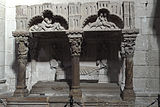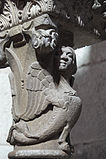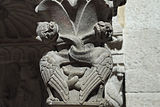Santa María Magdalena (Zamora)
The Roman Catholic Church of Santa María Magdalena in the Rúa de los Francos in Zamora , the capital of the province of the same name in the autonomous Spanish region of Castile-León , was started in the second half of the 12th century. The construction work dragged on until the early 13th century. The church, consecrated to Maria Magdalena , was originally owned by the Order of St. John . In 1910 the Romanesque church was declared a monument ( Bien de Interés Cultural ).
architecture
A semicircular apse adjoins the single-nave church in the east . The west facade is crowned by an open bell tower ( Espadaña ). A row of sculpted corbels runs under the roof of the nave and the apse . The outer walls of the ship are supported by strong buttresses . Four half-columns decorated with capitals structure the apse, through which three large arched windows framed by columns break through. In the south facade, two open twin windows and in the middle of a round window with quatrefoil tracery .
South portal
The church has three portals, of which the south portal is the most splendidly carved. It is slightly pointed and covered by four archivolts . Small human heads are depicted on the outer arch, palm leaves and leaf tendrils on the other. The inner arch is jagged. The archivolts are supported by slender columns and rest on fighters decorated with palm leaves over capitals on which foliage, harpies and other mythical creatures are depicted.
Romanesque tomb
The church has a tomb with a reclining female figure from the time the church was built. However, there is no evidence of the personality of the buried person. Urraca de Portugal (around 1151–1188) is believed to be the first wife of Ferdinand II of León and mother of Alfonso IX. from León. Because of the resemblance to the stone choir stalls of the Cathedral of Santiago de Compostela , the tomb is named Maestro Mateo , a sculptor from the 12th / 13th centuries. Century and creator of the Pórtico de la Gloria of the Cathedral of Santiago de Compostela, attributed.
The deceased is shown lying on a bed, surrounded by angels waving incense. Two other angels carry their souls to heaven in a sheet. A canopy resting on five columns covers the sarcophagus . The sides of the canopy are decorated with reliefs of dragons and harpies whose necks are intertwined. The capitals of the columns bear depictions of harpies and other bird-like creatures.
literature
- Jaime Cobreros: Las Rutas del Románico en España . Vol. 1, Madrid 2004, ISBN 84-9776-010-7 , pp. 218-219.
- Alberto Fernández Ferrero, Laura Illana Gutiérrez: Guía de Zamora y rutas por la provincia . Zamora 2010, ISBN 978-84-614-1351-5 , p. 34.
Web links
- Zamora - Santa María Magdalena Arte románico de la ribera del Duero (Spanish)
Coordinates: 41 ° 30 ′ 4.6 " N , 5 ° 45 ′ 1.3" W.






